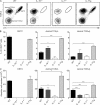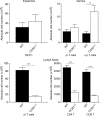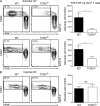Cutaneous immunosurveillance by self-renewing dermal gammadelta T cells
- PMID: 21339323
- PMCID: PMC3058585
- DOI: 10.1084/jem.20101824
Cutaneous immunosurveillance by self-renewing dermal gammadelta T cells
Abstract
The presence of γδ T cell receptor (TCR)-expressing cells in the epidermis of mice, termed dendritic epidermal T cells (DETCs), is well established. Because of their strict epidermal localization, it is likely that DETCs primarily respond to epithelial stress, such as infections or the presence of transformed cells, whereas they may not participate directly in dermal immune responses. In this study, we describe a prominent population of resident dermal γδ T cells, which differ from DETCs in TCR usage, phenotype, and migratory behavior. Dermal γδ T cells are radioresistant, cycle in situ, and are partially depend on interleukin (IL)-7, but not IL-15, for their development and survival. During mycobacterial infection, dermal γδ T cells are the predominant dermal cells that produce IL-17. Absence of dermal γδ T cells is associated with decreased expansion in skin draining lymph nodes of CD4(+) T cells specific for an immunodominant Mycobacterium tuberculosis epitope. Decreased CD4(+) T cell expansion is related to a reduction in neutrophil recruitment to the skin and decreased BCG shuttling to draining lymph nodes. Thus, dermal γδ T cells are an important part of the resident cutaneous immunosurveillance program. Our data demonstrate functional specialization of T cells in distinct microcompartments of the skin.
Figures









References
-
- Abadie V., Badell E., Douillard P., Ensergueix D., Leenen P.J.M., Tanguy M., Fiette L., Saeland S., Gicquel B., Winter N. 2005. Neutrophils rapidly migrate via lymphatics after Mycobacterium bovis BCG intradermal vaccination and shuttle live bacilli to the draining lymph nodes. Blood. 106:1843–1850 10.1182/blood-2005-03-1281 - DOI - PubMed
Publication types
MeSH terms
Substances
LinkOut - more resources
Full Text Sources
Other Literature Sources
Research Materials

